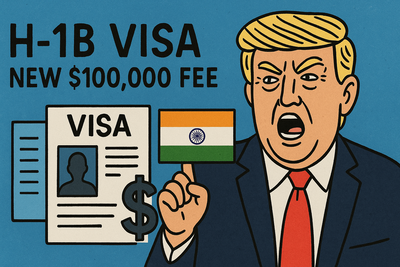ARTICLE AD BOX

In a move that has sent ripples across tech corridors and boardrooms alike, President Donald Trump turned his focus Friday to the H-1B visa program, a cornerstone of the United States’ skilled immigration framework.
Designed to attract talent where domestic labor falls short, the program has long been a flashpoint in debates over globalization, workforce protection, and the role of foreign talent in America’s economy.
With a newly signed proclamation introducing a $100,000 fee for new applicants, Trump’s administration is signaling a sharper stance on immigration, one that could reshape the professional landscape for thousands of software engineers, educators, and STEM specialists.
The H-1B visa: A tool for talent or a contested conduit?
Congress first created the H-1B visa in 1990, at a time when the nation faced looming shortages of highly skilled workers. Signed into law by President George H.W. Bush, the program was meant to encourage the immigration of exceptionally talented people, such as scientists, engineers, and educators. H-1B visas allow US employers to temporarily employ foreign workers in specialty occupations that require advanced knowledge, particularly in technology, science, and education.
Employers submit petitions detailing the job and the qualifications of prospective hires. While the visa confers temporary work authorization, many companies sponsor holders for green cards, allowing them to pursue US citizenship. Universities and research institutions enjoy exemptions from the program’s annual cap, which currently stands at 65,000 for bachelor’s degree holders and 20,000 for those with master’s degrees or higher, according to The New York Times.Over the years, the H-1B program has become synonymous with the American tech ecosystem. Giants such as Amazon, Google, Meta, Microsoft, Apple, and IBM have relied heavily on the program to fill critical roles. A large majority of recipients hail from India, often bringing spouses and children under dependent visas, creating long-term familial ties to the US.
Trump’s $100,000 fee
The new policy, announced in the Oval Office, imposes a $100,000 fee for new H-1B visa applicants.
Howard Lutnick, Secretary of Commerce, framed the fee as a corrective measure against what he described as the “most abused visa,” arguing that it will discourage companies from training foreign workers at the expense of domestic talent. “If you’re going to train somebody, you’re going to train one of the recent graduates from one of the great universities across our land,” Lutnick said.Confusion quickly followed. While Lutnick indicated the fee would be annual, White House press secretary Karoline Leavitt clarified that it would be a one-time payment.
Legal challenges are expected, and the fee is slated to take effect Sunday, applying only to new applicants.
Who stands to be affected?
The H-1B visa program primarily serves highly skilled professionals: software engineers, computer programmers, data analysts, and other tech specialists. Yet the ripple effects extend beyond Silicon Valley. Health care, education, and manufacturing sectors also rely on H-1B talent. Critics of the program argue that it enables companies to hire foreign workers at lower wages than American counterparts, a claim that has found support among some Republicans and Trump’s core supporters.
Meanwhile, tech leaders, whose companies are deeply dependent on H-1B workers, have voiced concern over the economic impact.
Historical tension: Replacement vs. opportunity
H-1B visas have occasionally been criticized for displacing American workers. Notable cases, such as the 2015 layoffs at Walt Disney World, Toys “R” Us, and New York Life, spotlighted situations where American employees were asked to train their replacements — H-1B visa holders brought in by outsourcing firms. Despite statutory protections requiring employers to pay H-1B workers at least the prevailing wage or the average wage for US-born employees in similar roles, about 60% of positions in 2019 paid below the local median, underscoring ongoing tensions over fairness and wage equity, as reported by the Times.
A crossroads for US talent and global ambition
Trump’s latest move encapsulates the broader debate over the balance between protecting domestic labor and attracting global talent. For companies reliant on specialized skills, the fee introduces both financial and operational hurdles. For aspiring foreign professionals, it raises questions about access, opportunity, and long-term planning for families who make the US their home.The H-1B program has always been more than a visa, it is a symbol of America’s capacity to harness global intellect, a conduit through which talent meets opportunity. As the new rules take effect, students, professionals, and policymakers alike will be watching closely to see how this recalibration reshapes the future of work in the United States.



.png)
.png)
.png)
















 1 hour ago
6
1 hour ago
6









 English (US) ·
English (US) ·